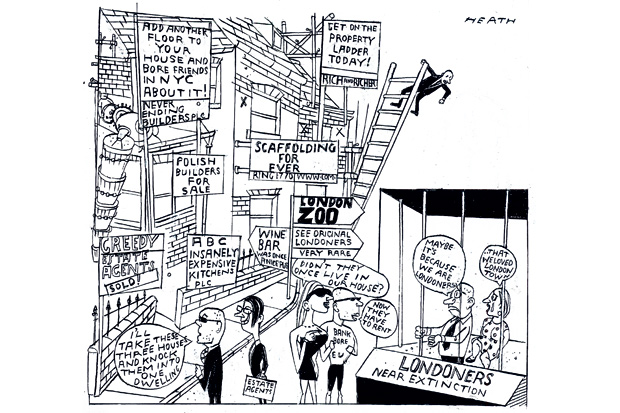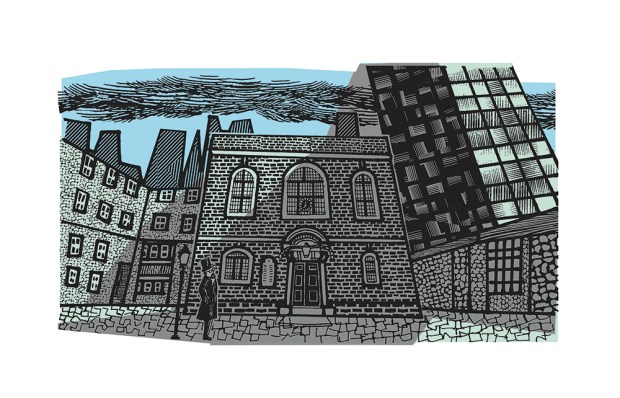Queuing to gain admittance to the pavement of Westminster Bridge on a ferociously hot Sunday afternoon recently, I found myself trapped. Pinioned by a road to one side, a stall selling models of Big Ben and snow-dome Buckingham Palaces to the other, and bordered by the great bronze statue of Boudicca, I was caught in a corralled mass of tourists and going nowhere fast. It occurred to me that the last time I experienced such a peculiar blend of urban misery was in Venice. This might have been the Rialto in August.
But it wasn’t the Grand Canal that we were crossing, it was the Thames, and it started me thinking about the similarities of life in London and Venice. And I don’t just mean being photographed occasionally by a tourist as if you were one of those rarefied Venetian gondoliers. It’s also the scary realisation that our city is being bought up — brick by brick — by rich foreigners, mostly representatives of a new pan-national global plutocracy. As a result, the average Brit looks up at the stuccoed terraces of Notting Hill or South Ken like a tramp pressing his nose against the glass of the Ivy.
According to Savills, the upmarket estate agent, the people buying up the nice bits of central London are mainly foreigners. Take what it calls ‘Prime Central London’: a severely desirable portion of land stretching from Chelsea in the south to St John’s Wood in the north, Notting Hill to the west and Mayfair to the east. In this area, six out ten property sales were made to buyers from overseas in 2011-12. Of these, 37 per cent were bought as a holiday home, meaning that one in five properties is now empty most of the time. The figures are even higher with new-build properties. Another estate agent, Knight Frank, says foreign buyers bought 73 per cent of new homes last year. Lots of these are offered to overseas -buyers first.
And don’t imagine it’s just the centre of town either — no borough is safe. Foreign property ownership is rising across the whole of London and entering cheaper market segments. At a conservative estimate, foreigners have spent £37 billion on top London property since 2006.
Partly as a result of this spree, London has three local authorities with the highest ratios of second homes in the UK. One in four households in the City of London is a second home, compared with one in ten in Kensington and Chelsea, and one in 20 in Westminster.
And here’s the danger for our great capital, the real peril of becoming a Venice: all those unlived-in houses kill the soul of a city.
I took a walk into Mayfair — prime -foreign-ownership territory — to take the city’s pulse. On Curzon Street I popped into Caffè Nero and asked the barista if they had any proper locals. He thought for a second. ‘I know one or two… I reckon there’s about ten,’ he said.
Over the road an estate agent has a window dedicated to property in Monaco, with prices starting at €4.2 million. Next door the beauty parlour is advertising an ‘eyelash perm’ for £45. Over the road a bookshop with a blue plaque announces that Nancy Mitford ‘worked here’ from 1942 to 1945. Not any more, she doesn’t.
On Chesterfield Street, with the exception of the Bahamas High Commission, the lights are generally out. Wooden shutters darken the ground floor windows of a house once home to the Liberal Prime Minister Lord Rosebery. At No. 4, Sir Anthony Eden’s old pad looks empty, as does its neighbours. The top-hatted doorman outside Aspinalls who has been working in the area for 30 years says the foreign owners spend a lot of time abroad.
I overhear a woman with an American accent and ask her if she’s a local. She is, she said, in London for her husband’s job. ‘I love it here so much.’
I popped into The Grapes on Shepherd’s Market for some refreshment. Does the pub have any proper locals? ‘It’s easy to work that one out,’ the landlord said, ‘because weekends are our quietest time. Still, we do better than some, they just close at weekends.’ Back on Curzon Street, the only lights I see are on the taxis — zooming back and forth looking for fares.
I put the London/Venice theory to Mark Field, the Conservative MP for the Cities of London and Westminster, and he agreed, but only on the grounds that ‘it’s the sheer power of London as a city state, like Venice was before the unification of Italy’.
He did admit that power and wealth make for inequality. ‘Central London has always been polarised between the very wealthy and the very poor and that polarisation is spreading throughout greater London. It’s not just an issue for a handful of MPs, but all 73 London constituencies.’
So what do we do? Accept the fact that our city is becoming a theme park for tourists and the global rich who want somewhere to work, rest, invest and play? Do we just take the money, flog our heritage, and move out? What happens to our authentic city, the cultural and political dynamo at the heart of our beating national enterprise? Shouldn’t we at least talk about this, before we let it happen?
I don’t want to be the last gondolier. Do you?
Got something to add? Join the discussion and comment below.
Get 10 issues for just $10
Subscribe to The Spectator Australia today for the next 10 magazine issues, plus full online access, for just $10.
You might disagree with half of it, but you’ll enjoy reading all of it. Try your first month for free, then just $2 a week for the remainder of your first year.














Comments
Don't miss out
Join the conversation with other Spectator Australia readers. Subscribe to leave a comment.
SUBSCRIBEAlready a subscriber? Log in